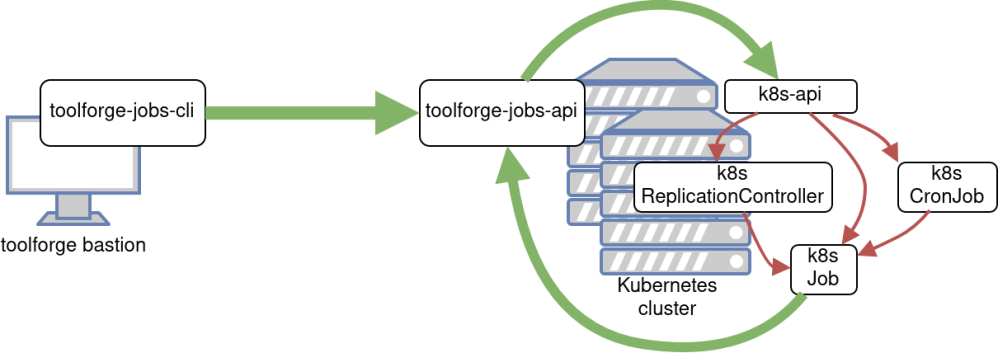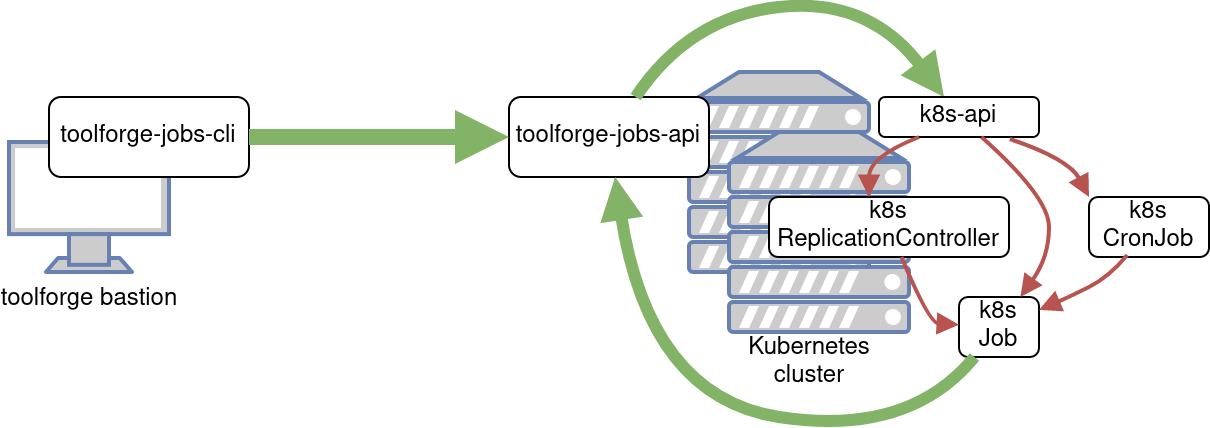Toolforge Jobs Framework
By Arturo Borrero González, Site Reliability Engineer, Wikimedia Cloud Services Team
This post continues the discussion of Toolforge updates as described in a previous post. Every non-trivial task performed in Toolforge (like executing a script or running a bot) should be dispatched to a job scheduling backend, which ensures that the job is run in a suitable place with sufficient resources.
Jobs can be scheduled synchronously or asynchronously, continuously, or simply executed once. The basic principle of running jobs is fairly straightforward:
- You create a job from a submission server (usually login.toolforge.org).
- The backend finds a suitable execution node to run the job on, and starts it once resources are available.
- As it runs, the job will send output and errors to files until the job completes or is aborted.
So far, if a tool developer wanted to work with jobs, the Toolforge Grid Engine backend was the only suitable choice. This is despite the fact that Kubernetes supports this kind of workload natively. The truth is that we never prepared our Kubernetes environment to work with jobs. Luckily that has changed.
We no longer want to run Grid Engine
In a previous blog post we shared information about our desired future for Grid Engine in Toolforge. Our intention is to discontinue our usage of this technology.
Convenient way of running jobs on Toolforge Kubernetes
Some advanced Toolforge users really wanted to use Kubernetes. They were aware of the lack of abstractions or helpers, so they were forced to use the raw Kubernetes API. Eventually, they figured everything out and managed to succeed. The result of this move was in the form of docs on Wikitech and a few dozen jobs running on Kubernetes for the first time.
We were aware of this, and this initiative was much in sync with our ultimate goal: to promote Kubernetes over Grid Engine. We rolled up our sleeves and started thinking of a way to abstract and make it easy to run jobs without having to deal with lots of YAML and the raw Kubernetes API.
There is a precedent: the webservice command does exactly that. It hides all the details behind a simple command line interface to start/stop a web app running on Kubernetes. However, we wanted to go even further, be more flexible and prepare ourselves for more situations in the future: we decided to create a complete new REST API to wrap the jobs functionality in Toolforge Kubernetes. The Toolforge Jobs Framework was born.
Toolforge Jobs Framework components
The new framework is a small collection of components. As of this writing, we have three:
- The REST API — responsible for creating/deleting/listing jobs on the Kubernetes system.
- A command line interface — to interact with the REST API above.
- An emailer — to notify users about their jobs activity in the Kubernetes system.

There were a couple of challenges that weren’t trivial to solve. The authentication and authorization against the Kubernetes API was one of them. The other was deciding on the semantics of the new REST API itself. If you are curious, we invite you to take a look at the documentation we have in wikitech.
Open beta phase
Once we gained some confidence with the new framework, in July 2021 we decided to start a beta phase. We suggested some advanced Toolforge users try out the new framework. We tracked this phase in Phabricator, where our collaborators quickly started reporting some early bugs, helping each other, and creating new feature requests.
Moreover, when we launched the Grid Engine migration from Debian 9 Stretch to Debian 10 Buster we took a step forward and started promoting the new jobs framework as a viable replacement for the grid. Some official documentation pages were created on wikitech as well.
As of this writing the framework continues in beta phase. We have solved basically all of the most important bugs, and we already started thinking on how to address the few feature requests that are missing.
We haven’t yet established yet the criteria for leaving the beta phase, but it would be good to have:
- Critical bugs fixed and most feature requests addressed (or at least somehow planned).
- Proper automated test coverage. We can do better on testing the different software components to ensure they are as bug free as possible. This also would make sure that contributing changes is easy.
- REST API swagger integration.
- Deployment automation. Deploying the REST API and the emailer is tedious. This is tracked in Phabricator.
- Documentation, documentation, documentation.
Limitations
One of the limitations we bear in mind since early on in the development process of this framework was the support for mixing different programming languages or runtime environments in the same job.
Solving this limitation is currently one of the WMCS team priorities, because this is one of the key workflows that was available on Grid Engine. The moment we address it, the framework adoption will grow, and it will pretty much enable the same workflows as in the grid, if not more advanced and featureful.
Stay tuned for more upcoming blog posts with additional information about Toolforge.
